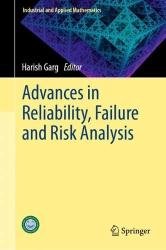 Название: Advances in Reliability, Failure and Risk Analysis
Название: Advances in Reliability, Failure and Risk AnalysisАвтор: Harish Garg
Издательство: Springer
Серия: Industrial and Applied Mathematics
Год: 2023
Страниц: 415
Язык: английский
Формат: pdf (true)
Размер: 10.2 MB
Reliability is a very crucial concept in a multifaceted term used in several fields from simple product design to complex industrial system such as nuclear power plant and aerospace engineering. The disseminate operation of every subsystem/component of an industrial system is ensured by its Reliability, Availability and Maintainability (RAM) aspects. The ability of equipment to work without failure is the focus of reliability engineering, a sub-discipline of systems engineering. However, with the growing complexity in the systems day-by-day, a failure analysis is an important and challenging aspect of the study of complex systems. A system is defined to be consisting of components, sub-systems, inputs and outputs within system boundaries. The inputs provide physical resources and information to the sub-systems, which are interacting among each other to produce some outputs. All interactions are assumed to take place within the system boundaries. A complex system can be defined as a system structure that is composed of usually a large number of components that have complex interactions. Any failure in performing the required interactions among the system components, or any failure in getting the expected output/result, is considered to be contributing to the system failure. Thus, analysis of a system with its components is a crucial step in determining the difficulties and complexities that the system will experience at any stage.
To increase the performance and life of the system, there is also a need to maintain the schedule of risk analysis at a regular interval of time. Risk and reliability analysis methods can allow for a systematic assessment of these uncertainties, supporting decisions integrating associated consequences in case of unexpected events. Risk is the effect of uncertainty on objectives and the associated likelihood of their occurrence. The development of risk estimates or the determination of risks in a given context is called risk analysis, while risk assessment is the process of evaluating the risks and determining the best course of action. Since, uncertainty is an intrinsic property of risk and is present in all aspects of risk management including risk analysis and risk assessment.
Generally, risk analysis is a systematic tool that facilitates the identification of the weak elements of a complex system and the hazards that mainly contribute to the risk. One of the significant advantages of a coordinated risk analysis approach is that safety, operational, and financial execution are frequently connected.
These days to support the plant design and accidental situations in any industrial plant, a concept of risk tool is considered as a necessity of expertise to tackle any such complicated and multidisciplinary issues in the systems. This entails the acquisition of appropriate reliability modelling and risk analysis tools to complement the basic and specific engineering knowledge for the technological area of application.
The book aims to help the managers and technical specialists with the design and implementation of reliability and risk programs under the following disciplines:
• System safety and risk informed asset management
• Proper strategy to maintain the mechanical components of the systems
• Schedule the proper actions throughout the product life cycle
• To understand the structure and cost of the complex systems
• Plan a proper schedule to improve the reliability and life of the systems
• Identify some unwanted failure and set up their associated preventive and correction actions
The book is useful to not only industry professionals but also for academicians, researchers and scholars. This book publishes the articles dealing with real industrial problems related to uncertainties and vagueness in the expert domain of knowledge. Further, this book also provides the knowledge related to applications of various mathematical and statistical tools in these areas. The results so presented in different chapters of this book will definitely open the gate for researchers and scientists in terms of handling complicated projects in the same domain.
Contents:
Скачать Advances in Reliability, Failure and Risk Analysis
